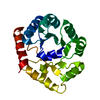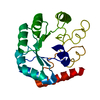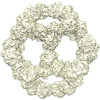+ Open data
Open data
- Basic information
Basic information
| Entry |  | |||||||||
|---|---|---|---|---|---|---|---|---|---|---|
| Title | Cryo-EM structure of Mi3 fused with FKBP | |||||||||
 Map data Map data | ||||||||||
 Sample Sample |
| |||||||||
 Keywords Keywords | protein cage Scaffold /  LYASE LYASE | |||||||||
| Function / homology |  Function and homology information Function and homology information macrolide binding / macrolide binding /  activin receptor binding / cytoplasmic side of membrane / activin receptor binding / cytoplasmic side of membrane /  transforming growth factor beta receptor binding / TGFBR1 LBD Mutants in Cancer / signaling receptor inhibitor activity / type I transforming growth factor beta receptor binding / negative regulation of activin receptor signaling pathway / heart trabecula formation / transforming growth factor beta receptor binding / TGFBR1 LBD Mutants in Cancer / signaling receptor inhibitor activity / type I transforming growth factor beta receptor binding / negative regulation of activin receptor signaling pathway / heart trabecula formation /  terminal cisterna ... terminal cisterna ... macrolide binding / macrolide binding /  activin receptor binding / cytoplasmic side of membrane / activin receptor binding / cytoplasmic side of membrane /  transforming growth factor beta receptor binding / TGFBR1 LBD Mutants in Cancer / signaling receptor inhibitor activity / type I transforming growth factor beta receptor binding / negative regulation of activin receptor signaling pathway / heart trabecula formation / transforming growth factor beta receptor binding / TGFBR1 LBD Mutants in Cancer / signaling receptor inhibitor activity / type I transforming growth factor beta receptor binding / negative regulation of activin receptor signaling pathway / heart trabecula formation /  terminal cisterna / terminal cisterna /  ryanodine receptor complex / ryanodine receptor complex /  I-SMAD binding / regulation of amyloid precursor protein catabolic process / protein maturation by protein folding / 'de novo' protein folding / ventricular cardiac muscle tissue morphogenesis / negative regulation of phosphoprotein phosphatase activity / I-SMAD binding / regulation of amyloid precursor protein catabolic process / protein maturation by protein folding / 'de novo' protein folding / ventricular cardiac muscle tissue morphogenesis / negative regulation of phosphoprotein phosphatase activity /  FK506 binding / mTORC1-mediated signalling / TGF-beta receptor signaling activates SMADs / Calcineurin activates NFAT / FK506 binding / mTORC1-mediated signalling / TGF-beta receptor signaling activates SMADs / Calcineurin activates NFAT /  regulation of immune response / protein peptidyl-prolyl isomerization / supramolecular fiber organization / heart morphogenesis / regulation of ryanodine-sensitive calcium-release channel activity / sarcoplasmic reticulum membrane / regulation of immune response / protein peptidyl-prolyl isomerization / supramolecular fiber organization / heart morphogenesis / regulation of ryanodine-sensitive calcium-release channel activity / sarcoplasmic reticulum membrane /  T cell activation / TGF-beta receptor signaling in EMT (epithelial to mesenchymal transition) / T cell activation / TGF-beta receptor signaling in EMT (epithelial to mesenchymal transition) /  sarcoplasmic reticulum / sarcoplasmic reticulum /  peptidylprolyl isomerase / peptidylprolyl isomerase /  peptidyl-prolyl cis-trans isomerase activity / calcium ion transmembrane transport / negative regulation of transforming growth factor beta receptor signaling pathway / Z disc / SARS-CoV-1 activates/modulates innate immune responses / peptidyl-prolyl cis-trans isomerase activity / calcium ion transmembrane transport / negative regulation of transforming growth factor beta receptor signaling pathway / Z disc / SARS-CoV-1 activates/modulates innate immune responses /  regulation of protein localization / regulation of protein localization /  protein folding / positive regulation of protein binding / protein refolding / positive regulation of canonical NF-kappaB signal transduction / Potential therapeutics for SARS / transmembrane transporter binding / amyloid fibril formation / protein folding / positive regulation of protein binding / protein refolding / positive regulation of canonical NF-kappaB signal transduction / Potential therapeutics for SARS / transmembrane transporter binding / amyloid fibril formation /  lyase activity / lyase activity /  membrane / membrane /  cytosol / cytosol /  cytoplasm cytoplasmSimilarity search - Function | |||||||||
| Biological species |    Thermotoga maritima (bacteria) / Thermotoga maritima (bacteria) /    Thermotoga maritima (strain ATCC 43589 / DSM 3109 / JCM 10099 / NBRC 100826 / MSB8) (bacteria) Thermotoga maritima (strain ATCC 43589 / DSM 3109 / JCM 10099 / NBRC 100826 / MSB8) (bacteria) | |||||||||
| Method |  single particle reconstruction / single particle reconstruction /  cryo EM / Resolution: 3.68 Å cryo EM / Resolution: 3.68 Å | |||||||||
 Authors Authors | Zhang HW / Kang W / Xue C | |||||||||
| Funding support |  China, 1 items China, 1 items
| |||||||||
 Citation Citation |  Journal: J Am Chem Soc / Year: 2024 Journal: J Am Chem Soc / Year: 2024Title: Dynamic Metabolons Using Stimuli-Responsive Protein Cages. Authors: Wei Kang / Xiao Ma / Huawei Zhang / Juncai Ma / Chunxue Liu / Jiani Li / Hanhan Guo / Daping Wang / Rui Wang / Bo Li / Chuang Xue /   Abstract: Naturally evolved metabolons have the ability to assemble and disassemble in response to environmental stimuli, allowing for the rapid reorganization of chemical reactions in living cells to meet ...Naturally evolved metabolons have the ability to assemble and disassemble in response to environmental stimuli, allowing for the rapid reorganization of chemical reactions in living cells to meet changing cellular needs. However, replicating such capability in synthetic metabolons remains a challenge due to our limited understanding of the mechanisms by which the assembly and disassembly of such naturally occurring multienzyme complexes are controlled. Here, we report the synthesis of chemical- and light-responsive protein cages for assembling synthetic metabolons, enabling the dynamic regulation of enzymatic reactions in living cells. Particularly, a chemically responsive domain was fused to a self-assembled protein cage subunit, generating engineered protein cages capable of displaying proteins containing cognate interaction domains on their surfaces in response to small molecular cues. Chemical-induced colocalization of sequential enzymes on protein cages enhances the specificity of the branched deoxyviolacein biosynthetic reactions by 2.6-fold. Further, by replacing the chemical-inducible domain with a light-inducible dimerization domain, we created an optogenetic protein cage capable of reversibly recruiting and releasing targeted proteins onto and from the exterior of the protein cages in tens of seconds by on-off of blue light. Tethering the optogenetic protein cages to membranes enables the formation of light-switchable, membrane-bound metabolons, which can repeatably recruit-release enzymes, leading to the manipulation of substrate utilization across membranes on demand. Our work demonstrates a powerful and versatile strategy for constructing dynamic metabolons in engineered living cells for efficient and controllable biocatalysis. | |||||||||
| History |
|
- Structure visualization
Structure visualization
| Supplemental images |
|---|
- Downloads & links
Downloads & links
-EMDB archive
| Map data |  emd_36228.map.gz emd_36228.map.gz | 483.6 MB |  EMDB map data format EMDB map data format | |
|---|---|---|---|---|
| Header (meta data) |  emd-36228-v30.xml emd-36228-v30.xml emd-36228.xml emd-36228.xml | 13.6 KB 13.6 KB | Display Display |  EMDB header EMDB header |
| FSC (resolution estimation) |  emd_36228_fsc.xml emd_36228_fsc.xml | 17 KB | Display |  FSC data file FSC data file |
| Images |  emd_36228.png emd_36228.png | 244.5 KB | ||
| Filedesc metadata |  emd-36228.cif.gz emd-36228.cif.gz | 5.3 KB | ||
| Others |  emd_36228_half_map_1.map.gz emd_36228_half_map_1.map.gz emd_36228_half_map_2.map.gz emd_36228_half_map_2.map.gz | 474.7 MB 474.7 MB | ||
| Archive directory |  http://ftp.pdbj.org/pub/emdb/structures/EMD-36228 http://ftp.pdbj.org/pub/emdb/structures/EMD-36228 ftp://ftp.pdbj.org/pub/emdb/structures/EMD-36228 ftp://ftp.pdbj.org/pub/emdb/structures/EMD-36228 | HTTPS FTP |
-Related structure data
| Related structure data |  8jgaMC  8jgcC M: atomic model generated by this map C: citing same article ( |
|---|---|
| Similar structure data | Similarity search - Function & homology  F&H Search F&H Search |
- Links
Links
| EMDB pages |  EMDB (EBI/PDBe) / EMDB (EBI/PDBe) /  EMDataResource EMDataResource |
|---|---|
| Related items in Molecule of the Month |
- Map
Map
| File |  Download / File: emd_36228.map.gz / Format: CCP4 / Size: 512 MB / Type: IMAGE STORED AS FLOATING POINT NUMBER (4 BYTES) Download / File: emd_36228.map.gz / Format: CCP4 / Size: 512 MB / Type: IMAGE STORED AS FLOATING POINT NUMBER (4 BYTES) | ||||||||||||||||||||||||||||||||||||
|---|---|---|---|---|---|---|---|---|---|---|---|---|---|---|---|---|---|---|---|---|---|---|---|---|---|---|---|---|---|---|---|---|---|---|---|---|---|
| Projections & slices | Image control
Images are generated by Spider. | ||||||||||||||||||||||||||||||||||||
| Voxel size | X=Y=Z: 0.83 Å | ||||||||||||||||||||||||||||||||||||
| Density |
| ||||||||||||||||||||||||||||||||||||
| Symmetry | Space group: 1 | ||||||||||||||||||||||||||||||||||||
| Details | EMDB XML:
|
-Supplemental data
-Half map: #1
| File | emd_36228_half_map_1.map | ||||||||||||
|---|---|---|---|---|---|---|---|---|---|---|---|---|---|
| Projections & Slices |
| ||||||||||||
| Density Histograms |
-Half map: #2
| File | emd_36228_half_map_2.map | ||||||||||||
|---|---|---|---|---|---|---|---|---|---|---|---|---|---|
| Projections & Slices |
| ||||||||||||
| Density Histograms |
- Sample components
Sample components
-Entire : FKBP-Mi3
| Entire | Name: FKBP-Mi3 |
|---|---|
| Components |
|
-Supramolecule #1: FKBP-Mi3
| Supramolecule | Name: FKBP-Mi3 / type: complex / ID: 1 / Parent: 0 / Macromolecule list: all |
|---|---|
| Source (natural) | Organism:    Thermotoga maritima (bacteria) Thermotoga maritima (bacteria) |
-Macromolecule #1: Peptidyl-prolyl cis-trans isomerase FKBP1A,2-dehydro-3-deoxyphosp...
| Macromolecule | Name: Peptidyl-prolyl cis-trans isomerase FKBP1A,2-dehydro-3-deoxyphosphogluconate aldolase/4-hydroxy-2-oxoglutarate aldolase type: protein_or_peptide / ID: 1 / Number of copies: 1 / Enantiomer: LEVO / EC number:  peptidylprolyl isomerase peptidylprolyl isomerase |
|---|---|
| Source (natural) | Organism:    Thermotoga maritima (strain ATCC 43589 / DSM 3109 / JCM 10099 / NBRC 100826 / MSB8) (bacteria) Thermotoga maritima (strain ATCC 43589 / DSM 3109 / JCM 10099 / NBRC 100826 / MSB8) (bacteria) |
| Molecular weight | Theoretical: 36.730309 KDa |
| Recombinant expression | Organism:   Escherichia coli (E. coli) Escherichia coli (E. coli) |
| Sequence | String: MGSSHHHHHH GGSGVQVETI SPGDGRTFPK RGQTCVVHYT GMLEDGKKFD SSRDRNKPFK FMLGKQEVIR GWEEGVAQMS VGQRAKLTI SPDYAYGATG HPGIIPPHAT LVFDVELLKL EGGSGGSGGS GGSMKMEELF KKHKIVAVLR ANSVEEAKKK A LAVFLGGV ...String: MGSSHHHHHH GGSGVQVETI SPGDGRTFPK RGQTCVVHYT GMLEDGKKFD SSRDRNKPFK FMLGKQEVIR GWEEGVAQMS VGQRAKLTI SPDYAYGATG HPGIIPPHAT LVFDVELLKL EGGSGGSGGS GGSMKMEELF KKHKIVAVLR ANSVEEAKKK A LAVFLGGV HLIEITFTVP DADTVIKELS FLKEMGAIIG AGTVTSVEQA RKAVESGAEF IVSPHLDEEI SQFAKEKGVF YM PGVMTPT ELVKAMKLGH TILKLFPGEV VGPQFVKAMK GPFPNVKFVP TGGVNLDNVC EWFKAGVLAV GVGSALVKGT PVE VAEKAK AFVEKIRGCT EGSGEPEA UniProtKB: Peptidyl-prolyl cis-trans isomerase FKBP1A, 2-dehydro-3-deoxyphosphogluconate aldolase/4-hydroxy-2-oxoglutarate aldolase |
-Experimental details
-Structure determination
| Method |  cryo EM cryo EM |
|---|---|
 Processing Processing |  single particle reconstruction single particle reconstruction |
| Aggregation state | particle |
- Sample preparation
Sample preparation
| Buffer | pH: 7.8 |
|---|---|
| Vitrification | Cryogen name: ETHANE |
- Electron microscopy
Electron microscopy
| Microscope | FEI TITAN KRIOS |
|---|---|
| Electron beam | Acceleration voltage: 300 kV / Electron source:  FIELD EMISSION GUN FIELD EMISSION GUN |
| Electron optics | Illumination mode: FLOOD BEAM / Imaging mode: BRIGHT FIELD Bright-field microscopy / Nominal defocus max: 2.5 µm / Nominal defocus min: 1.5 µm Bright-field microscopy / Nominal defocus max: 2.5 µm / Nominal defocus min: 1.5 µm |
| Image recording | Film or detector model: GATAN K3 BIOQUANTUM (6k x 4k) / Average electron dose: 50.0 e/Å2 |
| Experimental equipment |  Model: Titan Krios / Image courtesy: FEI Company |
 Movie
Movie Controller
Controller













 Z (Sec.)
Z (Sec.) Y (Row.)
Y (Row.) X (Col.)
X (Col.)







































